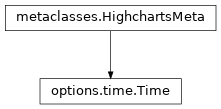.time
class: Time
- class Time(**kwargs)[source]
Time options that can apply globally or to individual charts. These settings affect how datetime axes are laid out, how tooltips are formatted, how series
point_interval_unit <Series.point_interval_unit()works and how the Highcharts Stock range selector handles time.Class Inheritance

- copy(other=None, overwrite=True, **kwargs)
Copy the configuration settings from this instance to the
otherinstance.- Parameters:
other (
HighchartsMeta) – The target instance to which the properties of this instance should be copied. IfNone, will create a new instance and populate it with properties copied fromself. Defaults toNone.overwrite (
bool) – ifTrue, properties inotherthat are already set will be overwritten by their counterparts inself. Defaults toTrue.kwargs – Additional keyword arguments. Some special descendents of
HighchartsMetamay have special implementations of this method which rely on additional keyword arguments.
- Returns:
A mutated version of
otherwith new property values
- classmethod from_dict(as_dict: dict, allow_snake_case: bool = True)
Construct an instance of the class from a
dictobject.
- classmethod from_js_literal(as_str_or_file, allow_snake_case: bool = True, _break_loop_on_failure: bool = False)
Return a Python object representation of a Highcharts JavaScript object literal.
- Parameters:
as_str_or_file (
str) – The JavaScript object literal, represented either as astror as a filename which contains the JS object literal.allow_snake_case (
bool) – IfTrue, interpretssnake_casekeys as equivalent tocamelCasekeys. Defaults toTrue._break_loop_on_failure (
bool) – IfTrue, will break any looping operations in the event of a failure. Otherwise, will attempt to repair the failure. Defaults toFalse.
- Returns:
A Python object representation of the Highcharts JavaScript object literal.
- Return type:
HighchartsMeta
- classmethod from_json(as_json_or_file, allow_snake_case: bool = True)
Construct an instance of the class from a JSON string.
- Parameters:
as_json_or_file – The JSON string for the object or the filename of a file that contains the JSON string.
allow_snake_case (
bool) – IfTrue, interpretssnake_casekeys as equivalent tocamelCasekeys. Defaults toTrue.
- Returns:
A Python objcet representation of
as_json.- Return type:
HighchartsMeta
- to_dict() dict
Generate a
dictrepresentation of the object compatible with the Highcharts JavaScript library.Note
The
dictrepresentation has a property structure and naming convention that is intentionally consistent with the Highcharts JavaScript library. This is not Pythonic, but it makes managing the interplay between the two languages much, much simpler.
- to_js_literal(filename=None, encoding='utf-8') str | None
Return the object represented as a
strcontaining the JavaScript object literal.
- to_json(filename=None, encoding='utf-8')
Generate a JSON string/byte string representation of the object compatible with the Highcharts JavaScript library.
Note
This method will either return a standard
stror abytesobject depending on the JSON serialization library you are using. For example, if your environment has orjson, the result will be abytesrepresentation of the string.- Parameters:
- Returns:
A JSON representation of the object compatible with the Highcharts library.
- Return type:
- static trim_dict(untrimmed: dict, to_json: bool = False) dict
Remove keys from
untrimmedwhose values areNoneand convert values that have.to_dict()methods.
- static trim_iterable(untrimmed, to_json=False)
Convert any
EnforcedNullTypevalues inuntrimmedto'null'.
- property Date: JavaScriptClass | None
A custom JavaScript
Dateclass for more sophisticated date handling. For example, JDate can be used to handle Jalali dates. Defaults toNone.- Return type:
JavaScriptClassorNone
- property get_timezone_offset: CallbackFunction | None
A JavaScript callback function that returns the time zone offset for a given datetime. Defaults to
None.The function is expected to take a Unix timestamp (as number of milliseconds since January 1, 1970) as an argument and return the timezone offset in minutes.
Hint
This provides a hook for drawing time based charts in specific time zones using their local DST crossover dates, with the help of external libraries.
Warning
If
Time.timezone()is specified, then this custom function will be overridden by an automatic function leveraging the moment.js library.- Return type:
CallbackFunctionorNone
- property moment: CallbackFunction | None
A JavaScript function that can be used to manually load the moment.js library when initializing a chart, rather than loading it from within
windowor a<script/>tag. Defaults toNone.Note
The function expects no arguments and returns no result.
Warning
If loading
moment.jsis loaded from within a<script/>tag on the page, this setting can be left asNone. Highcharts will still be able to access and use the library.- Return type:
CallbackFunctionorNone
- property timezone: str | None
Indicates the timezone in which to render the chart. Defaults to
None.If this value is provided, Highcharts will override the setting for
Time.get_timezone_offset()with a default function leveraging the moment.js library.Warning
Requires moment.js to work properly. If
moment.jsis not available, this will throw a Highcharts error in the JavaScript console but will not prevent the chart from rendering.
- property timezone_offset: int | None
The timezone offset to apply in minutes. Defaults to
0.Hint
Use this to display UTC data in a predefined timezone.
Note
Positive values are west of UTC. Negative values are east of UTC, as in the ECMAScript getTimezoneOffset() method.
- property use_utc: bool | None
If
True, use UTC time for axis scaling, tickmark placement, and time display. Defaults toTrue.Hint
The advantage of using UTC is that the time displays equally regardless of the user agent’s time zone settings. Local time can be used when the data is loaded in real time or when correct Daylight Saving Time transitions are required.